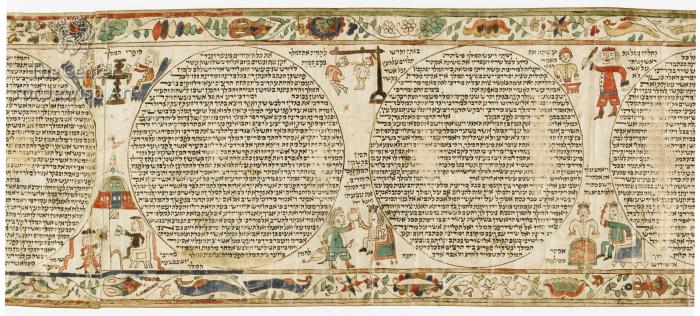
E | Esther, Book of (following the order of the story) | Coronation of Esther (Es. 2:17)
E | Esther, Book of (following the order of the story) | Bigthan and Teresh hanged (Es. 2:23)
E | Esther, Book of (following the order of the story) | Ahasuerus handing his ring to Haman (Es. 3:10)
E | Esther, Book of (following the order of the story) | Scribe(s) writing Haman's decree (Es. 3:12)
O | Ornamentation: | Foliate and floral ornaments
F | Flower
B | Bird
E | Esther, Book of (following the order of the story) | Mordecai at the king's gate (Es. 2:19 and/or 2:21)
E | Esther, Book of (following the order of the story) | *Esther's Story Characters (depicted not in narrative scenes): | Esther, the queen
E | Esther, Book of (following the order of the story) | *Esther's Story Characters (depicted not in narrative scenes): | Ahasuerus, the king
O | Ornamentation: | Main text framed
|
The opening part is very dark and the decorations on it are damaged.
Some parts of the text are erased.
Sheet no. 1
The upper and lower margins are decorated with belts filled with foliate and floral ornaments in which birds are woven.
Illustrations between roundels nos. 3 and 4: The upper scene shows the execution of Queen Vashti (not mentioned in the Book of Esther). On the right, an executioner in a red suit is shown and on the left, the upper half of Vashti can be seen (not visible in this photograph). It is inscribed in Hebrew:
התליון נטל את ראש ושתי על אשר לא עשתה את מאמר המלך
The lower scene shows the coronation of Esther (Es. 2:17): King Ahasuerus sits on the throne with a scepter in his hand and Esther is standing in front of him; both are crowned. The scene is inscribed in Hebrew:
ויאהב המלך את אסתר וישם כתר מלכות בראשה. מלך אחשורוש. אסתר המלכה.
Illustrations between roundels nos. 3 and 4: The upper scene presents the king's chamberlains, Bigthan and Teresh, hanged on a gallows (Es. 2:23). The scene is inscribed in Hebrew:
בגתן ותרש תלוים על העץ על אשר בקשו להמית את המלך בסם המות
The lower scene presents King Ahasuerus on the throne giving a huge ring to Haman (Es. 3:10). The scene is inscribed in Hebrew:
המן בקש מן המלך לאבד היהודים ויסר המלך את טבעתו מעל ידו ויתנה להמן
Illustrations between roundel nos. 4 and 5: The upper scene shows two scribes sitting at a round table with a vase (?) who are writing one of the decrees (possibly Haman's decree, Es. 3:12). It is inscribed סופרי המלך ("the king's scribes").
The lower scene shows Mordecai on a chair, inscribed מרדכי יושב בשער המלך, and a soldier with a sword and halberd, inscribed שומר שער ("guard of the gate").
The first membrane ends between roundels nos. 4 and 5.
The Book of Esther in Hebrew
The scroll is formed of 3 sheets containing in total 9 columns of text (8 of them is written in roundels) with 28, 30, or 31 lines each, except for col. 8 which has 11 lines divided into two half-columns.
The number of columns of text per sheet: no. 1 - 4 columns, no. 2 - 3 columns, no. 3 - 2 columns.
The text is written in Hebrew square Ashkenazi script with tagin in dark brown and brown ink on parchment membranes.
The letters ח (Es. 1:6) and ת (Es. 9:29) are enlarged and bolded. Other enlarged and diminished letters are included in col. 8.
The letters of the name of God are marked with tagin bent to the right.
Several letters in the scroll are decorated with tiny swirls.
The ruling is almost invisible; only in a few places, its traces can be discerned.
The pricking on the membranes' edges can be seen; it is visible either on the side of the text and decorations or on the blank side of the parchments.
The membranes of the scroll are glued together.
None
The third membrane is different from the two first membranes in the scroll; it is more suede and yellower than them and its quality influenced the text and decorations.
The fragments of the scroll are reproduced in some publications, but no comprehensive discussion on it is available.



